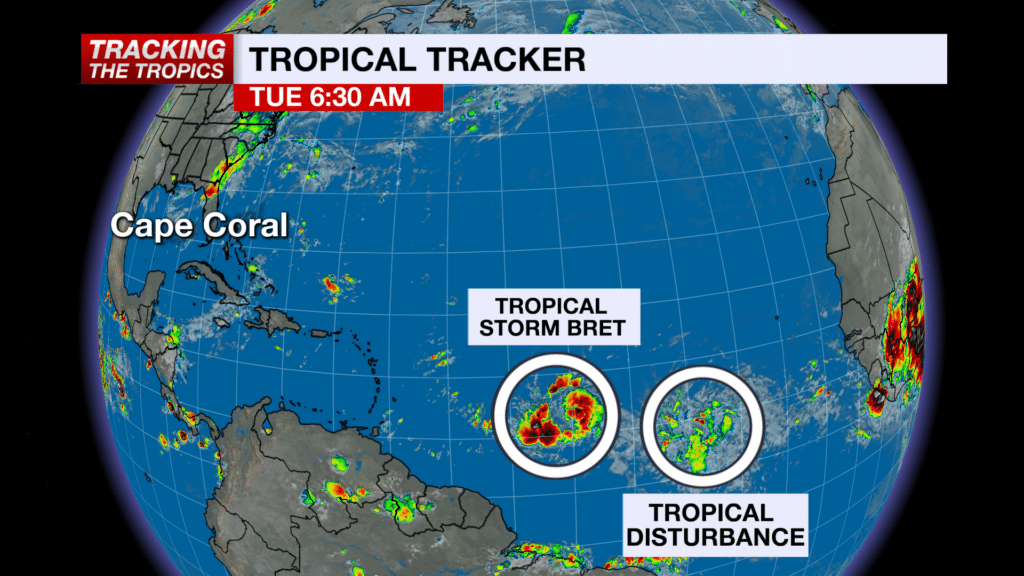Tracking the Tropics: Another Disturbance Follows Tropical Storm Bret
As we enter the heart of the hurricane season, the Atlantic Basin remains highly active. Following closely on the heels of Tropical Storm Bret, another disturbance has caught the attention of meteorologists. This disturbance, currently located east-southeast of the Caribbean, is showing signs of organization and could potentially develop into a tropical cyclone. Understanding and tracking these weather phenomena are crucial in order to provide accurate forecasts and ensure the safety of coastal communities.
The Current State of the Disturbance
The disturbance, labeled Invest 96L by the National Hurricane Center (NHC), is currently situated over the warm waters of the tropical Atlantic Ocean. While it doesn’t yet possess a well-defined center or sufficient circulation, atmospheric conditions are becoming favorable for development. Warm sea surface temperatures and low wind shear are conducive to the formation of a tropical cyclone.
Meteorologists are closely monitoring the disturbance’s progression, analyzing data from satellites, buoys, and other advanced weather monitoring systems. These tools help to gain insight into the disturbance’s structure, intensity, and potential track. However, accurately predicting the behavior of tropical systems remains a challenging task due to their complex nature and susceptibility to rapid changes.
Potential Impacts on the Caribbean Islands
While the exact future track of the disturbance is still uncertain, there is a possibility that it could impact the Caribbean islands. The NHC is urging residents and tourists in the region to closely monitor updates and be prepared for any potential developments. Heavy rainfall, strong winds, and rough surf conditions could occur, posing threats to life and property.
In preparation for the disturbance, emergency management agencies and local government officials in the Caribbean are taking necessary steps to ensure the safety of their communities. These measures include public awareness campaigns, pre-storm preparations, and coordination with relevant organizations such as the Caribbean Disaster Emergency Management Agency (CDEMA).
Implications for the United States and Beyond
While the primary concern currently lies with the Caribbean islands, the potential track of the disturbance beyond that point cannot be disregarded. Depending on its strength and path, it could potentially impact the southeastern coast of the United States or even the Gulf of Mexico. This highlights the importance of ongoing monitoring and the need for individuals along these coastlines to stay informed and prepared.
Coastal residents should have an emergency plan in place, including supplies, evacuation routes, and knowledge of local emergency shelters. It is important not to wait until a storm is approaching to begin preparations, as this could lead to unnecessary panic and limited supplies.
The Importance of Accurate Forecasts
The ability to accurately track tropical disturbances and provide timely forecasts is crucial for effective disaster management. By predicting the future track and intensity of storms, meteorologists can provide valuable information to emergency response teams and the public, allowing for appropriate preparations and response measures.
Advancements in technology, such as weather satellites, computer models, and improved data assimilation techniques, have greatly improved our ability to forecast tropical systems. However, the dynamic nature of these storms demands constant monitoring and updates, as even minor changes in atmospheric conditions can significantly alter their path.
Community Preparedness and Resilience
While meteorologists and emergency response teams play a critical role in tracking and forecasting tropical disturbances, community preparedness and resilience cannot be overlooked. The public should actively engage in disaster preparedness education and take necessary measures to protect themselves and their properties.
Creating a disaster supply kit, developing an evacuation plan, and staying informed through reliable sources are some key steps individuals can take to ensure their safety during hurricane events. Additionally, communities should invest in infrastructure improvements, such as storm surge protection systems and resilient building codes, to reduce the vulnerability of coastal areas.
Conclusion
The ongoing tracking and monitoring of tropical disturbances, like the one following Tropical Storm Bret, are essential in safeguarding communities across the Caribbean islands and potentially the United States. Through accurate forecasting and effective disaster management, we can minimize the impact of these natural hazards. However, it is the responsibility of individuals, communities, and governments to remain vigilant, prepared, and resilient in the face of such threats as we continue to navigate the 2021 hurricane season.




































